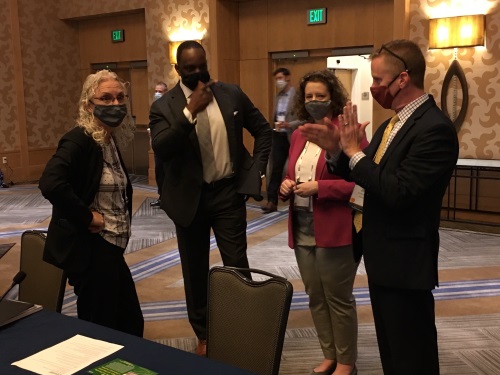The American Association of State Highway and Transportation Officials Council on Active Transportation is planning to implement a “research roadmap” finalized in July to “prioritize and categorize” state DOT pedestrian and bicycle infrastructure investments in the near future.
[Council Chair Toks Omishakin, director of the California Department of Transportation, is second from left in the above photo with Vice-Chair Melissa Batula, deputy secretary for highway administration for the Pennsylvania Department of Transportation, at far left.]
That roadmap – developed via the National Cooperative Highway Research Program or NCHRP – seeks to focus on six specific areas:
- Applying and integrating active transportation data into planning and operations
- Using minimum accommodations versus alternative approaches to increase active transportation
- Determining context-driven optimal spacing between marked crosswalks
- Addressing barriers to integrating active transportation throughout planning and engineering practice
- Racial and economic disparities in pedestrian and bicyclist safety
- Speed management solutions and strategies to improve pedestrian and bicyclist safety on arterial roadways
“As you know, the Active Transportation Council was created as part of the AASHTO restructuring a few years ago, born from the institutional desire to make active transportation more prominent within the association,” explained Omishakin during a panel discussion during AASHTO’s annual meeting in San Diego.
“The Active Transportation Council has also successfully collaborated with various AASHTO committees in 2021,” he added. “For example, earlier this year, we worked with the Committee on Safety to hold a peer exchange on active transportation safety, with the discussion including data collection, asset management, plus project planning and delivery.”
Omishakin emphasized that, in terms of active transportation external engagement, AASHTO entered into a memorandum of understanding or MOU in February with the Adventure Cycling Association in terms of expanding their joint efforts to expand the U.S. Bicycle Route System or USBRS. That helped spur the designation of 18 new bicycle routes in five states in August, adding 2,903 miles to the USBRS – representing the largest addition to the USBRS to date in terms of both the number of designations and their total mileage.
“We have identified a lot of ways to help one another and work together,” Omishakin stressed during the council’s session at the AASHTO annual meeting. “We will keep both the internal and external conversations and coordination going.”

